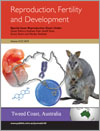
Reproduction, Fertility and Development
Volume 31 Number 7 2019
Reproduction Down Under
Marilyn Renfree was recognised as ‘a giant of marsupial embryology’; the author had spent her working life studying genes and chromosomes. Marilyn and Jenny teamed up out of mutual respect to form, with Des Cooper, the ARC Centre of Excellence in Kangaroo Genomics. This is the story of how their collaboration came to be, and what it has produced for our knowledge of some of the world’s most remarkable animals.
Sequencing of marsupial genomes is helping us understand the evolution of features unique to marsupials. However, the DNA sequence is only one part of the dynamic structures it is packaged into: chromosomes. We need to consider how changes in chromosome packaging and how different chromosomes interact in a cell to fully understand the evolution of marsupial-specific features.
RD18176The origins of genomic imprinting in mammals
Genomic imprinting is an epigenetic process that causes genes to be expressed according to their parental origin. We present a comprehensive review of current research on the origins of genomic imprinting in mammals. We focus on the evolution of imprint protection, a role that is predominantly provided by zinc finger protein 57 (ZFP57), a Kruppel associated box (KRAB) zinc finger protein, in eutherians. ZFP57 is absent in marsupials suggesting an, as yet unidentified, ancestral imprinting protection factor also exists.
RD18176 Abstract | RD18176 Full Text | RD18176PDF (525 KB) Open Access Article
RD18127Evolution of viviparity in mammals: what genomic imprinting tells us about mammalian placental evolution
Why is genomic imprinting widely conserved in mammals and how is it related to viviparity? It is likely that genomic imprinting has played a role as a genome defence mechanism against the insertion of exogenous DNA and arose as an evolutionary trade-off for survival. Domestication of two retrotransposon-derived imprinted genes, namely paternally expressed 10 (Peg10) and Peg11 or retrotransposon Gaglike 1 (Rtl1), must have played important roles in the emergency and establishment of mammalian viviparity, respectively.
RD18127 Abstract | RD18127 Full Text | RD18127PDF (927 KB) Open Access Article
RD18235New functions for old factors: the role of polyamines during the establishment of pregnancy
Polyamines are small, ubiquitous molecules essential for cell proliferation and growth that are involved in multiple aspects of reproduction. Recent results have highlighted the importance of polyamines in coordinating the molecular signalling that occurs between the embryo and uterus to control the events surrounding implantation. Identification of the essential role for polyamines during this critical stage is providing new insights into the requirements for the establishment of a successful pregnancy.
RD17501Persistent Müllerian duct syndrome: an update
How do men develop a uterus and what are the consequences? Learn about persistent Müllerian duct syndrome, a rare condition caused by disruption of the genetic pathway spearheaded by anti-Müllerian hormone (AMH). AMH suppresses internal female primordia, whereas testosterone, the other testicular product, builds the visible attributes of masculinity.
RD18121Opossum milk IgG is from maternal circulation and timing of transfer correlates with neonatal immune development
Transcript abundance of immunoglobulin isotypes and relevant transporters, FcRN and pIgR, were quantified within the opossum mammaries throughout lactation. Results support the presence of a dynamic lactation scheme in the opossum mammary that correlates with neonatal immune development.
RD18197Marsupial milk: a fluid source of nutrition and immune factors for the developing pouch young
At birth, the tammar wallaby (Macropus eugenii) neonate is essentially an exteriorised fetus. Therefore, during the 300–350 day lactation cycle, the tammar mother progressively alters milk composition, volume and individual milk constituents to provide appropriate nutrients for the pouch young. This review examines the correlation between changes in maternal milk and developmental milestones in the young, and explores the role of selected milk components.
RD18199Comparative analysis of milk microRNA in the therian lineage highlights the evolution of lactation
Regulatory microRNA have only recently been identified in milk of a growing number of mammals and their origin and function are the subject of active investigations. Here, the milk miRNA content of five therian mammals including one marsupial are compared. The results show how the diversity of miRNA profiles reflect the phylogeny and identifies conserved and specific secretory milk miRNA.
RD18271The tammar wallaby: a non-traditional animal model to study growth axis maturation
Marsupials, particularly the tammar wallaby, are great experimental models for understanding the developmental relationship between nutrition, growth and endocrinology because most of their growth occurs in the pouch external to the mother’s body. Here we discuss some of the key findings to date and contrast these with reproductive strategies in eutherian mammals.
RD18142Non-invasive genetic sexing technique for analysis of short-beaked echidna (Tachyglossus aculeatus) populations

The lack of external differences hampers the identification male and female echidnas in the wild and in captivity. Here, we developed a non-invasive genetic method to determine the sex of echidnas with DNA from a few hair samples. With this technique, male or female specific genetic markers were amplified to identify the sex of 10 juvenile echidnas born at Perth Zoo. This method assists captive management and breeding and also has potential applications in wildlife research and conservation of this iconic species.
Tasmanian devils are threatened by devil facial tumour disease, a transmissible cancer with a high fatality rate. In response, the Save the Tasmanian Devil Program established a breeding program as an ‘insurance population’ that has been integral to the conservation of the species. Studying the genetic diversity of the species in the wild and in captivity has enabled us to improve the reproductive success of devils.
The successful implementation of assisted breeding technology in marsupials and monotremes has major positive implications for their future genetic management and conservation. Although there have been exciting advances in techniques such AI resulting in the production of koala joeys, there are still many Australian mammals for which very little is known about their reproduction. We can only truly conserve a species once we understand how it works, and this requires a return to and support of fundamental studies that examine reproductive anatomy, physiology and behaviour.



